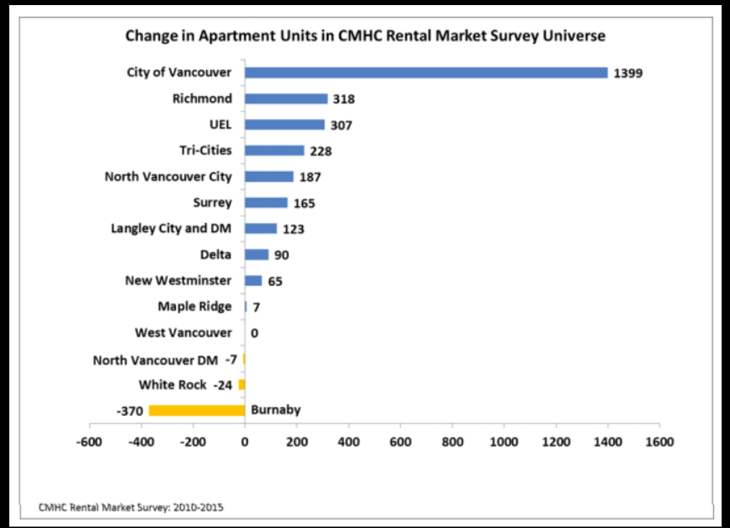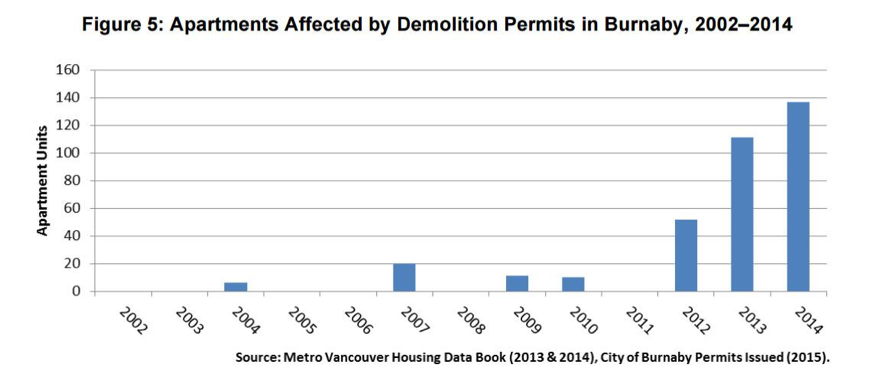
Organized destruction – CMHC data reveals the City of Burnaby is hemorrhaging apartments
A reporter from Metro News contacted me to get my reaction to a graphic illustrating the change in numbers of apartment units in the Lower Mainland. To be blunt, it makes Burnaby look bad. In fact, awful. This isn’t some partisan survey put out by some special interest group. This is a graph made by the City of Vancouver from data collected by the Canada Mortgage Housing Corporation and it still looks awful!

The reporter asked me if I was surprised by what the graphic showed. Sadly, I could not say I was surprised.
You would think any other municipality would look at this and go into full damage control pulling out the bylaws and land use maps and try to figure out how the heck they got into this quagmire and how are they going to fix it. Not Burnaby.
City of Burnaby’s organized destruction of apartments
In 2010, Burnaby council made a “text amendment” to its bylaws regarding what they refer to as “supplementary” density. S-Zoning as it is called applies only to Burnaby’s town centers and effectively allows developers to add additional floors in exchange for cash or community amenities. Usually, they opt to pay the cash. Developers are more than willing to pay for extra floors because the higher up you go, the more floor space you can sell on a single lot, the better the views, and the higher the price buyers are willing to pay. Burnaby’s S-Zoning policy incentivized high rise development if the City was willing to rezone. And rezone they have.

Passing the buck on demovictions
According to Burnaby’s leadership, they are doing all they can. Demovictions are everyone else’s fault.
The conclusion of Burnaby’s 2016 housing profile states, “Our long-term approach to housing has facilitated positive outcomes across the housing continuum”….”Looking ahead, the City will continue to support all aspects of the housing program and will consider ways in which to build upon its foundations.” The leadership is Burnaby cannot fathom doing anything new.
When the finalized version of the Metro Vancouver’s Regional Affordable Housing Strategy was released, the City endorsed it; however several actions from the original draft were deleted at the urging of Burnaby. These include:
- Require one for one replacement policies where existing rental supply is being redeveloped. DELETED
- Enact standards of maintenance bylaws to preserve the stock in good condition and prevent further erosion of existing rental stock. DELETED
- Purchase and hold sites/air space parcels for new non-profit housing to be made available as funding becomes available, focusing on the Frequent Transit Network. DELETED
- Establish an agreement with TransLink and the Province with the objective of generating funding to achieve goals for low to moderate income housing near the Frequent Transit Network. DELETED
Burnaby has the resources to improve life for renters
Burnaby Mayor Derek Corrigan says it isn’t “up to the property taxpayer to try and subsidize the other people’s homes.” This conservative logic guards Burnaby’s vaults. Every year the City of Burnaby overestimates how much it plans to spend and underestimates how much they will collect in property taxes. Consequently, Burnaby has surpluses in the tens, even hundreds of millions of dollars that the City has shoveled into a reserve. Burnaby’s reserve now stands at roughly a billion dollars- that’s a thousand millions. Is this sound financial management or bad forecasting?
Additionally, the City of Burnaby holds approximately 403 properties held for resale which have been acquired over the period of a hundred years. The City is unwilling to disclose the specific addresses of all properties held for resale, their purchase price and date of purchase as it “would be harmful to the economic interests of the City to do so.” The value of land is based on the “historic” cost of the property which ranges from $125 – $8.2 million. In 2015, the accumulated surplus in land inventory held for resale was $101,992,562. At today’s prices this land is valued significantly more. Traditionally the role of municipalities in developing social housing has been to provide the land, while senior governments provide funding for building and operations.
The City sits on a billion-dollar taxpayer funded reserve, and it holds hundreds of millions of dollars in land. But Burnaby is not designating its property holdings for social housing to replace lost rentals, even while we have the worst performance of any Lower Mainland municipality in retention of purpose built rental apartments.
Fortunately, the unyielding demands for social justice by the Alliance Against Displacement and ACORN, the scrutiny of the regional press and the unbiased data that is accumulating on the issue of affordability are beginning to shatter the lies and expose the truth. I am hopeful things will change for renters in Burnaby. They must.
